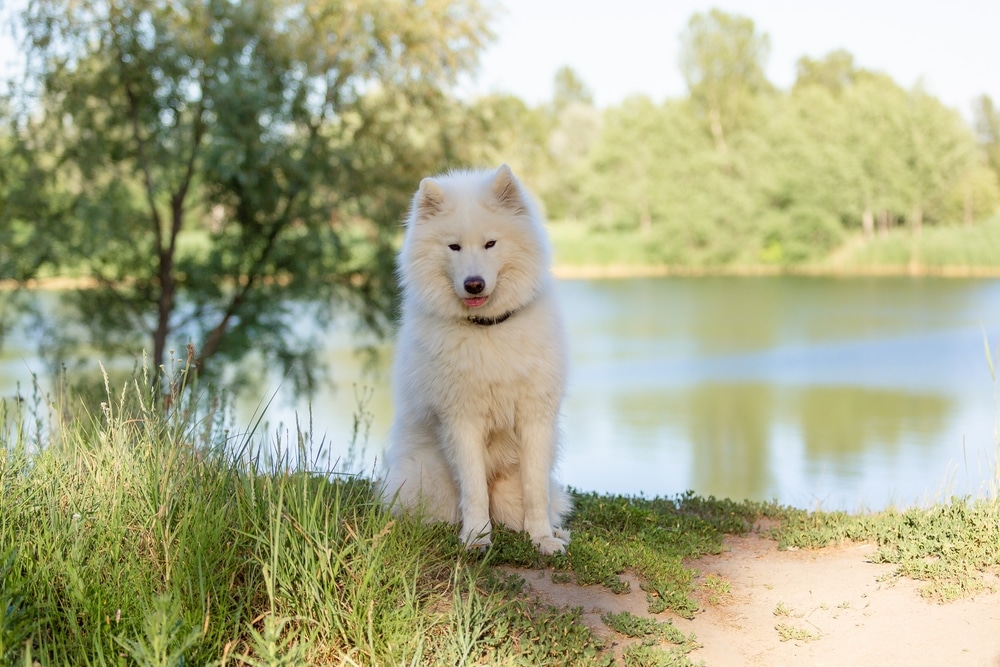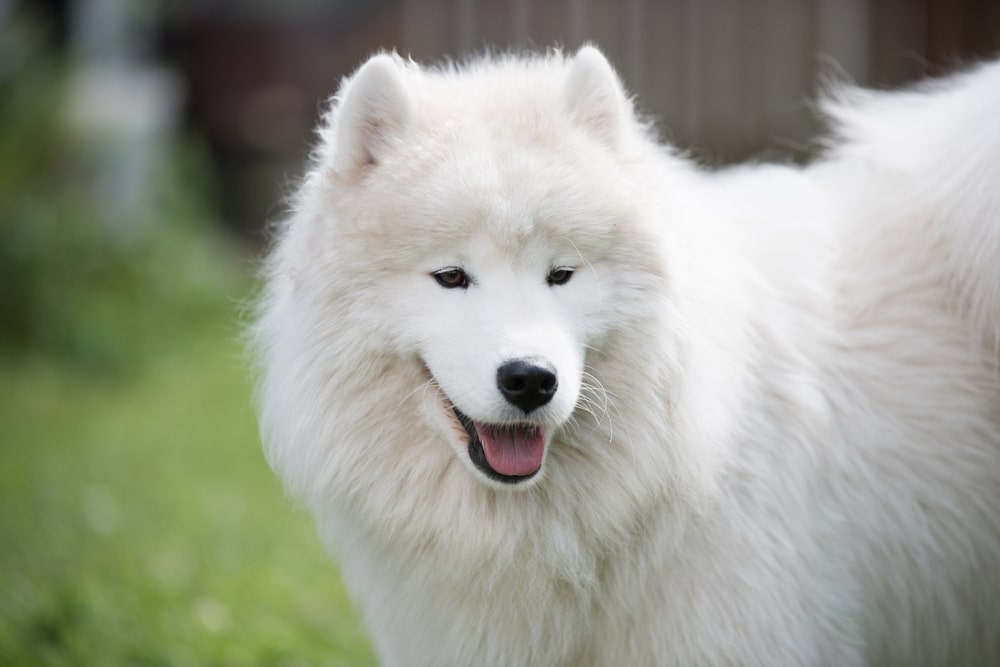Often referred to as puffy and fluffy snowflakes, Samoyeds win the hearts of people all over the world. This medium-sized dog, famous for its long and white fur, was once used for herding and safeguarding livestock for the nomadic people of Siberia. It does leave one wondering though, “Are Samoyeds purebred?”
Samoyeds are purebred dogs. The Kennel Club classifies them in the pastoral group, while FCI lists them as a primitive breed. Dogs can only be listed in these ways and obtain pedigrees if they are purebred dogs.
Table of Contents
What Does “Purebred Dog” Mean?
This term explains to the future owner that their puppy comes from a litter, both parents of which come from the same breed. They have a long lineage behind them, bred for specific characteristics. Although this may not make them healthier than other dogs, knowing the breed helps vets determine some diseases with a genetic background.
Another point worth mentioning is every purebred dog is registered with one of the different kennel clubs, like AKC, FCI, etc. That means every owner should get a piece of paper, called a pedigree, and it’s possible for an owner to inform themselves about their puppy’s ancestors. Usually, if an owner follows their lineage, it will lead them to the first creators of the breed. Cool, huh?
So, Are Samoyeds Purebred?
With that said, we can confirm Samoyeds are purebred dogs. How though? It’s easy thanks to the characteristics that make a Samoyed a Samoyed. These include things like having white, fluffy fur, pointy ears, and a big smile.
Seeing these traits, you instantly know you’re looking at a Samoyed. These are also the traits dog shows expect to see too. This is according to a guide called a standard. They are usually unique to each breed, and they are the ones that categorize the Samoyed as we know them today.
The American Kennel Club puts Samoyeds in the pastoral group for several reasons. Those are because pastoral-group dogs show herding instincts. As a result, humans used them to cattle, sheep, and reindeer safe from predators. They also have long, double coats to protect them from the cold. They’re also particularly smart and full of energy. Sound familiar?
Breed History: Where Does The Samoyed Come From?

It is not a surprise a dog with a thick double coat comes from the cold regions of Siberia, Russia. During the day, humans used Samoyeds to pull heavy loads long distances in extreme weather conditions. Samoyeds also assisted in reindeer herding. In the evening, they would stay close to their owners, curled up and keeping them warm. Doing this helped this breed become a family pet.
In the late 18th century, a British explorer named Ernest Killburn-Scott was mesmerized by the warm-hearted animals, so he brought a brown puppy back to England. Later, other explorers imported a cream bitch together with a white puppy boy, and together with other dogs, they are the base for today’s Samoyed as we know it. It didn’t take long for the British elite to favor Samoyeds.
Characteristics Of Samoyeds
Whenever you are getting a new puppy and especially if you are a first-time owner, it is always good to thoroughly research the breed you are interested in. Unfortunately, many times, purebred dogs end up in shelters. This is because when they grow up they become too hard to manage and train. Consequently, this puts stress on every dog that ends up in the shelter.
So, What Should You Know About The Samoyed?
This old breed was bred for work. So, if you decide on taking a Samoyed puppy, expect a dog that will need lots of time outdoors and regular long walks. They are super smart, loyal companions, and great with kids. But as with any breed, you should never leave small kids unsupervised with the dog. However, if you are not prepared for this type of commitment, expect a dog that may get destructive.
How To Best Take Care Of Your Samoyed?
Every owner should expect to spend at least a couple of hours per day either training, playing, or grooming their Samoyed.
Training starts from an early age, as this is a loyal breed that connects well with its family but also has a mind of its own. Use positive reinforcement with lots of treats whenever they do what you want them to. Correct them when they fall short too. Doing both of these things will transform your Samoyed into a pup worth bragging about in no time!
Also, socialization is mandatory! Expose your pup to different people, situations, places, children, and dogs. Doing so will develop your Samoyed into a stable, confident dog. Also, make sure the training sessions are not too long but always fun for both you and your pup. There is nothing better than a happy and tired doggo at the end of the day.
One should also be aware that the gorgeous snow-white fur does not keep itself clean! If you want a dog with that kind of look, you’ll need to spend plenty of time grooming your Samoyed. Many times, owners choose to take their dogs to professional groomers. Either way, you should brush your dog on a daily basis, just so its fur does not get tangled. Also, this breed sheds a lot, which means you should be prepared to see white puffs of fur flying in your home. My advice: invest in a good vacuum!
Owners should also regularly cut or trim the nails and clean a Samoyed’s ears in order to prevent possible ear infections.
Possible Samoyed Medical Issues
Since this is a breed with a long history, hence the classification as a primitive breed according to FCI, it means that in its creation and standardization, there weren’t many other dog breeds that contributed to its making. This makes the Samoyed a relatively healthy dog. However, as with any purebred dog, Samoyeds are prone to a few medical issues.
Hip And Elbow Dysplasia
This is a degenerative condition in medium- and large-sized breeds affecting the hip and elbow joints. Depending on the degree, owners can manage it with diets and pain medicine. In more severe cases it may require surgery.
Progressive Retinal Atrophy (PRA)
This is another degenerative disease affecting the retina of the eye and causing it to deteriorate. Affected dogs eventually lose their sight.
Samoyed Hereditary Glomerulopathy
This condition affects the glomerulus of the kidney, which is the main machinery for filtering urine. In this case, since the glomerules can’t filter properly, they excrete proteins such as albumin in larger amounts in the urine. Over time, this inappropriate filtration damages the kidney and can lead to chronic kidney failure.
Heart Problems
Samoyeds have a predisposition for some heart issues as well. The most common problems are pulmonic stenosis, where there is a narrowing of the pulmonic valve, and aortic stenosis, which is similar to pulmonic stenosis but in this case, it’s the aortic valve that is affected.
Samoyeds are also prone to atrial septal defect, in which case, an opening between the left and right side of the heart does not fully close after birth. This causes the heart to overwork and over time, it can lead to heart failure.
Conclusion: Are Samoyeds Purebred?
So, has this breed won you over yet? If the answer is yes, then our recommendation is to always look for reputable breeders. The reason is that responsible breeding can prevent some of the mentioned health issues. Breeders test their dogs and puppies before they send them to their new homes, and they also can be your best advisors for raising a Samoyed puppy.
Have in mind that owning a Samoyed is a long-time commitment. Dogs are not Christmas or birthday presents for one day. Samoyeds have a life expectancy between 10-14 years, which means you need to be well aware of what adventure you are getting into.
So, what do you think about Samoyeds? Do you already own one or are you looking to get one? Let us know your thoughts in the comments below!
